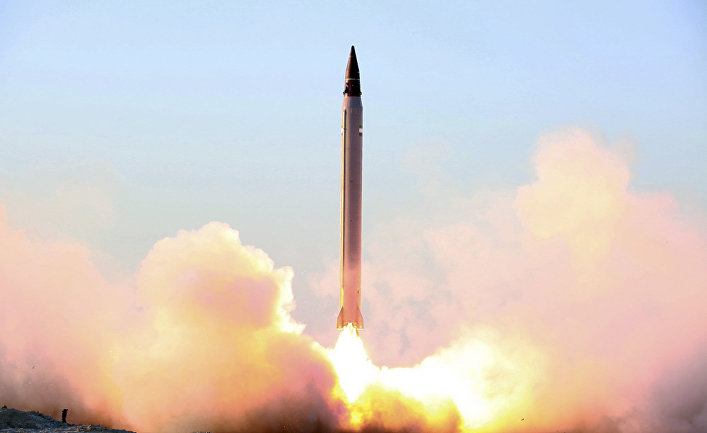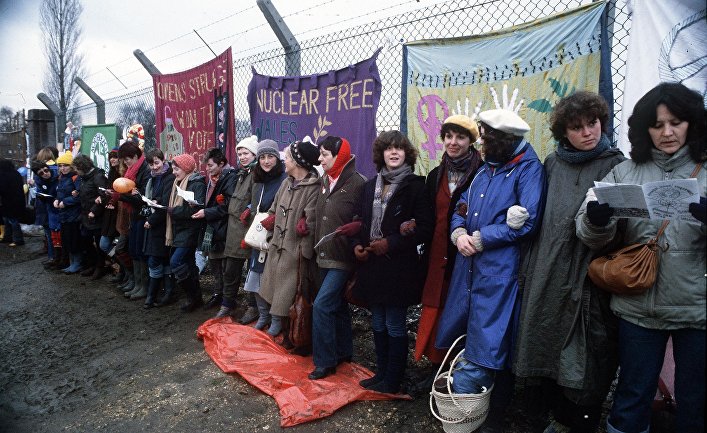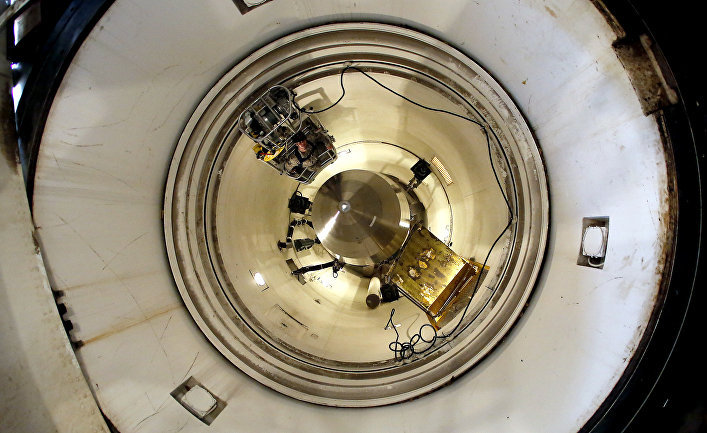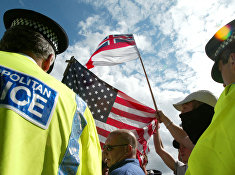Poland is considering housing American nuclear weapons within its borders – as announced on 6 December by the Polish Deputy Minister of Defense, Tomasz Szatkowski. Then the Polish Defense Ministry denied what their Deputy Minister had said, later the very same day. Instead, the generals explained that Poland is “thinking about some form of participation” in America's Nuclear Sharing program — but this does not provide for the location of American nuclear weapons in Poland. The Polish Republic — as the generals hastened to remind us — is a signatory to the Non-Proliferation Of Nuclear Weapons Treaty (NPT), and they intend to carry out the treaty's conditions scrupulously. However, as Lenta.Ru has discovered, participation in the NPNW Treaty hasn't prevented other signatories from housing American nuclear weapons.
Rooking the Russkies
Non-peaceful American nukes turned up in Europe a decade-and-a-half after the end of WW2, when the superpower military boffins fell in love with the idea of deploying nuclear weapons at a tactical level – bombs, nuclear weapons for artillery applications, and short-range missiles.
One especially seductive concept of tactical nuclear weapons (TNWs) appealed to the leadership of NATO and the USA of that period. The Pentagon brass-hats remained certain that if the alarm went up, an armada of Soviet tanks would be rumbling across Europe towards English Channel in a matter of days. Tactical nuclear weapons would wave an armored fist at the Soviets — making it clear that they would suffer unacceptable losses if they attempted any kind of first strike.
Russia: US has deployed 200 nukes to Turkey, Germany, Italy, Belgium & Netherlands https://t.co/GuSgVnM5Og See: https://t.co/USrwTrkXOm
— WikiLeaks (@wikileaks) December 12, 2015
The result was that TNWs were placed in American-ally nations and along the line of NATO members whose territories happened to coincide with the probable advance-route of the putative Soviet invaders – Germany, the Netherlands, and Belgium. The southern flank was covered by missiles based in Turkey, while any hypothetical advance of the Red Army and its allies through the Balkans was staunched by nuclear forces stationed in Greece and Italy. Meanwhile the nuclear arsenal installed in Greece in 1964 was intended not only for strikes against Bulgaria — but also against Albania and Yugoslavia. They may not have been Warsaw Pact members, but the NATO strategists weren't going to risk it. The program was titled Nuclear Sharing.
Nukes in Poland? ‘Warsaw completely controlled by US’ https://t.co/4k3ilaPakU #nuclearweapons pic.twitter.com/4ngccbEW8U
— Sputnik (@SputnikInt) December 7, 2015
Britain stood alone among the nations of Europe, as being the only country to actually possess nuclear weapons. Margaret Thatcher — Britain's “Iron Lady” — sought to underscore Britain's 'special relationship' with the USA, and its commitment to NATO, and she went further, deciding to support the deployment of land-based missiles such as the BGM-109 ('Tomahawk') and Pershing short-range missiles in Europe. Additionally, Thatcher gave her blessing to the Pentagon's placement of more than 160 cruise missiles at Greenham Common, Berkshire. During the 1980s the Americans went on to station around 400 Pershing and Tomahawk missiles, armed with nuclear warheads, throughout Germany, the UK, Italy and the Netherlands – allegedly in response to the threat posed by the Soviet 'Pioneer' system, also known as the SS-20. The USSR raised the game, by stationing missiles in E Germany and Czechoslovakia.
The “Reds Under The Bed” had to be fended off in the East, too. American tactical nuclear weapons were stationed in Japan and South Korea, ready for use if war broke out with the USSR, the People's Republic of China, or with North Korea. And America even kept a nuclear arsenal by its own side – atomic bombs were on hand in Canada at the 5 Wing Goose Bay air base, where the Boeing CIM-10 Bomarc guided missile system was installed in the 1950s – and somewhat later equipped with nuclear warheads.
The people oppose them
There were regular protests in the countries where the USA deployed these weapons. People in the USSR often talked about these demonstrations, as illustrating the struggle of ordinary people in the West against rampant militarism, and in favor of world peace. Of course, the organizers of such demonstrations were usually left-wing organizations, sometimes including the Communists. Yet the underlying motive of the demonstrators was simpler – fear for themselves and their families in the event of nuclear war. Everyone knew that American bases and their surrounding areas would be primary targets in the event of the outbreak of such a war.
Mass protests in favor of nuclear disarmament were held in Greece, Germany and Japan – but Britain led the way in this field. During the 1980s the American air base at Greenham Common was besieged by hordes of protesters, primarily women. What began as a spontaneous demonstration turned into a long-term tent-based demonstration presence, year-round outside the base. In 1983 the demonstrations reached a peak — when over 70,000 protesters formed a human chain around the air base. Women lay on the ground in front of the vehicles which tried to bring the missiles into the base. They fixed photographs of children to the wire fences of the air base, and chained themselves to the gates.
The protest camp remained in operation outside the base for nearly 19 years, and was only closed down in 2000. American missiles were withdrawn from Britain in 1992, and five years later the base itself was dismantled – but the Greenham women said they would nevertheless continue to demonstrate in support of pacifism.
But the politicians are all in favor
The political elite of the countries where American nuclear weapons have been deployed have used the presence of the weapons for political leverage on a wide range of issues, in both foreign and domestic policy. If Thatcher demonstrated the alleged loyalty of London to Washington, then Canadian PM Pierre Trudeau used American nukes to score political points. In 1971 he solemnly announced that he was removing all American nuclear weapons from his country. However, the Pentagon were quite unworried by his gesture — since intercontinental ballistic missiles had already superseded the role formerly played by the outdated Boeing Bomarc Canada-based system.
It was America's habitual policy not to ask the opinions of people living in areas where weapons were being deployed. In the tough times of the Cold War, democracy took second place. In the case of the Athens deployments from 1959 onwards, the Americans signed the contract for deployment of nuclear weapons in utter secrecy. The same thing was repeated in Japan – the decision to begin shipping nuclear weapons to Japanese ports was taken without even notifying Tokyo ahead of the event. News of this decision was made public only fifty years later.
#US #Nuclear Weapons In #Europe — Massive Protest Planned Against New Atomic Weapons In #Germany — http://t.co/M2erjLF38s
— Joe Thorpe (@JoeThorpe1963) October 3, 2015
Protests outside American bases barely worried Washington in any case. Demonstrations, rallies, papier-maché dragons, and the protesting women who carried these dragons to the Greenham Common air base, hardly caused the Pentagon to break sweat. Tactical nuclear weapons were only eventually withdrawn from European countries when there was no further political need for them.
In 1987 Gorbachev and Reagan signed the Treaty on the Elimination of Intermediate and Short-Range weapons, and in 1991 the Treaty actually came into effect. The Cold War effectively ended. It no longer made much sense to maintain nuclear weapons along the borders of the Commonwealth of Independent States. In September 1991 President George HW Bush announced a unilateral initiative to reduce the numbers of TNWs, after which they were quickly withdrawn from both S Korea and Japan. A decade later, and this time without a solemn pledge, his son George W Bush removed TNWs from Great Britain and from Greece, in addition to substantially reducing the nuclear arsenals held in Germany and Italy.
However, Americans can go into reverse on things just as quickly. In 1995 all countries in the waiting-list to join NATO were suddenly required to state their national policy on the option for tactical nuclear weapons to be stationed in their countries. In the countries where weapons had been withdrawn, the Americans nevertheless did not rush to demolish the storage facilities. In Greece, for example, the entire infrastructure for storing and deploying TNWs was left completely operational. It would have needed just a week to move the bombs themselves back into the waiting facilities.
The cycle of Tactical Nuclear Weapons
Today there are six bases in Europe (two in Italy, and one each in Germany, Belgium, the Netherlands and Turkey) which between them store 180 nuclear bombs – a fifth of the entire American nuclear arsenal. A further nine countries – Great Britain, Hungary, Greece, Denmark, Poland, Norway, Portugal, Romania, and the Czech Republic – operate air patrols, make reconnaissance missions, run communications and refueling missions whilst keeping tactical nuclear weapons on board the aircraft. France does not maintain any American nuclear weapons within its territories, and does not take part in Nuclear Sharing, yet nevertheless approves of the USA stationing its weapons in Europe.
Tactical nuclear weapons continue to be an important factor in NATO planning. In June 2013 Washington signed-off the latest – the third, if we count them – concept for for TNWs. The concept is described as a 'tool for regional containment', and the 'connecting line for member countries of the Alliance.' Its operation is regularly practiced in command-post drills throughout Europe.
At the present time, the Pentagon is carrying out extensive modernization of all its tactical nuclear forces. This means replacing its B61-11 bombers with the less-powerful but more easily controllable B61-12 aircraft. This creates a conflict which some German parliamentarians have identified as dangerous. For example, at Germany's Büchel Air Base, where the USA stores its nuclear warheads, the only aircraft from which they could be dropped are the German 'Tornado' fighter-bomber. This means that in the event of a nuclear conflict, the only pilots capable of dropping these bombs would be Germans. This is a clear breach of Germany's commitments to the NPT, which clearly spell out that American weapons may only be used by American pilots.
The latest threat
Conflict in Ukraine, and the worsening political climate in Eastern Europe has once again brought the topic of US tactical nuclear weapons to the fore. In June 2015 the media reported that US cruise missiles have once again been stationed in the UK. Phillip Hammond, the British FM, gave an interview in which he said that this move was intended to “prevent Russia from crossing the red line.” Although the decision related only to the stationing of American nuclear weapons within the British Isles, this interview was widely read as being the words of a minister who has already taken a decision. The sharp reaction which followed was entirely expected. Kate Hudson, the General Secretary of the Campaign for Nuclear Disarmament said these plans were “madness.” “In the 1980s the USA first stationed its Pershing cruise missiles in Europe. Which meant that everyone understood perfectly that in the event of nuclear war, it won't be the American owners of those missiles who will be annihilated – it will be us, the Europeans.”
Moscow considers presence of US nuclear weapons in Europe in military planning http://t.co/mVQX79ngaA
— TASS (@tassagency_en) September 22, 2015
But when it comes to the decision of the Polish Deputy Minister of Defense on the need to deploy American tactical nuclear weapons in his country, it seems his thinking is identical to that of Britain's Phillip Hammond. Petr Topychkanov, Senior Fellow in charge of the “Issues of Non-Proliferation” Program at the Carnegie Centre in Moscow, made the following comment. “On one hand, the political circles of Poland and Ukraine have been considerably, well, if you don't like the word 'panicked', then at least 'very seriously concerned' by Moscow's actions. Obviously Warsaw is interested in getting firm guarantees from the USA that if bad goes to worse, NATO will definitely come forward to protect its members. But on the other hand, such statements about possible threats from Russia could alternatively be seen as ways for Poland to sweeten its relations with the USA and other members of NATO.”
It all gives us pause for thought about the meaning of the words of Polish Deputy Minister of Defense, Tomasz Szatkowski. Particularly when we bear in mind that pilots from Poland and the Baltic States have already been getting NATO training on the deployment and firing of nuclear weapons, if we believe some sources. Let us not forget, the flight time from Polish military air bases to strategic sites on the western borders of Russia can be as little as four to seven minutes.
Meanwhile Poland's loony nationalist government wants to play with NATO nukes against Russia. Bring it on, baby! https://t.co/aP9HAYlDFg
— Mark Ames (@MarkAmesExiled) December 6, 2015
However, Topychkanov believes that NATO has little motivation at present to make a bad situation worse. “The talk among NATO's Eastern-European members about joint missions with nuclear weapons comes primarily from Poland. However, Poles are unlikely to give unanimous support for the deployment of US nuclear bombs in their own native land” he says. “Against the background of the latest military technologies, any potential use of TNWs would look quite out of place. NATO hasn't got any need to move nuclear weapons up closer to the Russian border. All that would do is make NATO more vulnerable whilst making the situation even more unstable. Serious people in both Moscow and Brussels understand all this very fully.”
Europe is a very large place. If the Americans take a look at the question of placements of their nuclear weapons in NATO allied countries in the cold light of day, it's far from certain that other nuclear powers, especially the fairly young ones, will follow suit. Relatively recently there have been media reports that Pakistan has located tactical nuclear weapons within Saudi Arabia. And even if the facts don't quite fit the story, it means that the idea is sitting hanging in the air. Because if one nuclear state can do it – why can't the others do so too?








